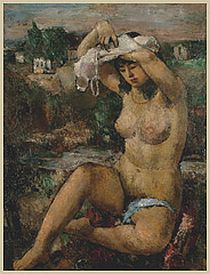


Serbia – Moments of Beauty and Joy 6

In between the yearly Magnificent 7, The Popovics (Svetlana and Zoran), the organisers of the festival, that takes place every year in January in Belgrade, and has done so for seven years, with my privileged post as co-selector of the seven films to be screened, have arranged the most beautiful (almost) film-free tours for me and my wife. The reason why this post is numbered 6 refers to the fact that we 3 years ago went to the South of Serbia, this time to the North, to Vojvodina. And if anyone wants to have the most competent, dedicated and knowledgeable introduction to culture and history, as well as current life situation of the Serbs, The Popovics is the best you can get for tours in Serbia. And please remember to hire Mijovic Milovan, Misko, the 2 meter high warm and safe driver to take you around in his combi.
Vojvodina… flat most of the time, full of colours, villages to watch when driving down the long and straight roads with houses behind the trees that line the road and with benches for the inhabitants to sit and enjoy the wonderful, sunny autumn weather. Sava Sumanovic (1896-1942) painted these roads again and again, as well as winter landscapes that demonstrated that he was ”a master of light”, as Zoran Popovic put it. His museum in Sid, close to Belgrade, clearly documents why Sumanovic was highly estimated internationally, (also) due to his stay in Paris where several of his paintings include the flamboyant Kiki de Montparnasse as model.
Flat, yes, but Fruska Gora mountains break this with its national park, and invites you to vineyards (try the kadarka grape) and monasteries with frescoes of great beauty.
Back to visual art, to mention the Pavle Beljanski Museum in Novi Sad. The diplomat (1892-1965) acquired the most complete collection of Serbian
paintings from the first half of the 20th century and the exhibition rooms invite you to see works of Sumanovic, Bijelic (photo) and Nadeda Petrović, just to mention three artists, whose works pleased the eyes of this blogger.
Which was also very much the case at the Kovacica Centre of Naive Art, placed in one of those typical Vojvodina villages, a house discreetly behind the trees, and you open the door to the works of ”the Queen of Naive art” Zuzana Halupova and Martin Jonas, both of Slovak origin, the latter famous for giving his characters biiig hands and feet. Please click on the links below to watch examples of the artists mentioned.
Back in Belgrade, we went South again, having the pleasure of watching a rough-almost-fine-cut of Sonja Blagojevic upcoming film from Kosovo. The film, produced by Kvadrat, the company of The Popovics, describes the difficult life of Serbs in Kosovo, seen from the point of view of people working with Kosma (working title of the film), five radio stations that broadcast in Serbian language. Blagojevic has worked on the film for three years and what has come out of it is an impressive professional work, warm and non-agressive, informational and emotional. This is the first time I have seen such a decent insight to the life conditions of the Serbs in Kosovo, made from a positive angle – the engaged radio people, who want to communicate and convey facts and emotions. Watch out for this film, festival people!
Photo: Jovan Bijelic: Bather (1929), part of the Pavle Beljanski Collection.
http://www.savasumanovic.com/katalozi/1e/
http://en.wikipedia.org/wiki/Zuzana_Chalupov%C3%A1
http://www.pavle-beljanski.museum/en/home.php
http://www.kosmainfo.net/index_eng.html